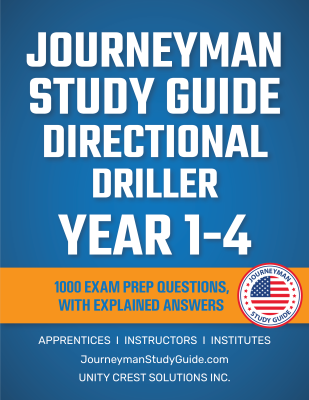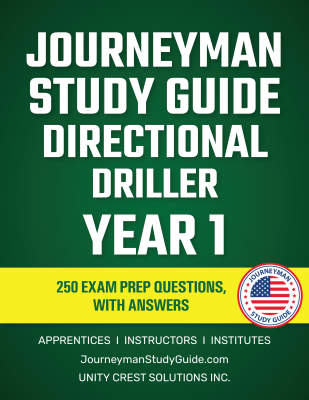Questions, Answers, & Explanations
Get clear explanations behind every answer, perfect for deeper learning and more thorough exam preparation.
Site Updates in Progress: Things might look different as we work on enhancing your experience.
What is a Directional Driller?
A directional driller operates specialized equipment to drill at precise angles for oil, gas, and utility installations. Their work enables pipelines, communication cables, and underground utilities to be installed without disrupting roads, buildings, or the environment. Directional drilling is crucial in offshore oil rigs, urban infrastructure projects, and remote drilling locations.
Key Responsibilities
Directional drillers must combine technical expertise, precision, and problem-solving skills to complete complex drilling operations. Their daily responsibilities include:
Skills and Traits for Success
A successful directional driller must have:
Industries Where Directional Drillers Thrive
Directional drillers play a critical role in multiple industries, including:
Why Choose This Career?
A career in directional drilling offers high demand, job security, and strong earning potential:
Get Certified and Advance Your Career
Proper training in drilling operations, safety protocols, and downhole technology is essential for success. Our Q&A study materials, online tests, and certification prep guides provide the knowledge needed to excel in the field of directional drilling.
What to Expect on the Directional Driller Certification Exam
The Directional Driller Certification Exam assesses technical knowledge, safety awareness, and drilling competency. Many employers, including Halliburton, Schlumberger, and Baker Hughes, require certification to verify a driller's ability to operate advanced drilling systems safely and efficiently.
Exam Format
The certification exam consists of both written and practical components:
Key Topics Covered
Passing Requirements
Most certifying bodies require a minimum score of 70% to pass. Practical assessments may involve simulated drilling operations where candidates must demonstrate precision in drill path navigation and troubleshooting techniques.
Tips for Effective Exam Preparation
Get Ready to Pass Your Exam
Our Q&A study guides, detailed explanations, and online tests help you build confidence and prepare for the Directional Driller Certification Exam.
What Types of Questions Are on the Exam?
The Directional Driller Certification Exam assesses knowledge of drilling operations, safety regulations, and tool functionality. Understanding the question formats helps candidates prepare effectively.
Common Question Formats
Sample Questions
Study Smarter, Pass Faster
Our Q&A products break down complex topics, while our Online Tests provide real-time performance tracking.
What Is It Like to Work as a Directional Driller?
The daily life of a directional driller is fast-paced and physically demanding, requiring precise coordination, problem-solving, and technical expertise. These professionals operate high-tech drilling systems to create underground paths for oil, gas, and utility infrastructure.
Morning: Pre-Drill Setup & Planning
Midday: Active Drilling Operations
Afternoon: Completion & Reporting
Challenges & Rewards
Ready to Start Your Career?
Prepare with our study guides, Q&A products, and interactive online tests designed for directional drillers.
What Are the Long-Term Benefits of a Career in Directional Drilling?
Directional drilling offers high earning potential, career advancement, and specialized skill development. Professionals in this field can move up to lead driller, drilling supervisor, or even start their own HDD business.
Career Progression
Top Employers & Career Opportunities
Union & Certification Benefits
Why This Career Matters
Directional drilling plays a crucial role in energy independence, infrastructure expansion, and environmental protection.
Take the Next Step
Advance your career with our study guides, Q&A materials, and interactive online tests tailored for directional drillers.
How Much Can You Earn as a Directional Driller?
Wages for directional drillers vary based on experience, location, and industry demand. High-paying roles exist in oil fields, infrastructure drilling, and HDD (Horizontal Directional Drilling) projects.
Wage Breakdown by Experience Level
Factors That Impact Earnings
Maximize Your Earning Potential
Advance your career with our Q&A study materials, certification prep courses, and interactive online tests.
Essential Tools for Directional Drilling
Recommended Training Programs
Get Equipped for Success
Prepare for certification with our study guides, Q&A resources, and interactive online tests tailored for directional drillers.
Where Can You Train to Become a Directional Driller?
Education programs in the U.S. provide hands-on training in horizontal directional drilling (HDD), mud motor technology, and downhole surveying. These programs prepare students for careers in oil, gas, infrastructure, and utility drilling.
Types of Training Programs
What to Expect in Training Programs
How to Choose the Right Program
Advance Your Skills with Professional Training
Becoming a certified directional driller requires technical expertise, safety training, and hands-on experience. Our Q&A study materials and online tests help reinforce key concepts and prepare for certification exams.
Why Join a Union or Work with a Reputable Employer?
Union membership and employment with established oil, gas, and infrastructure drilling companies provide job security, competitive wages, and career advancement opportunities.
Benefits of Union Membership
Top Unions for Directional Drillers
Leading Employers Hiring Directional Drillers
What Employers Look For
How to Get Hired as a Directional Driller
Why Unions & Employers Matter
Unions and reputable employers ensure stable employment, high wages, and ongoing training opportunities for directional drillers.
Secure the Best Career Opportunities
Enhance your employability by getting certified and joining a union. Use our study guides, Q&A materials, and online tests to ensure success in directional drilling exams.
How to Stay Ahead in the Directional Drilling Industry
The directional drilling industry is evolving rapidly, driven by advances in telemetry, automation, and sustainability. Whether you're drilling in the Permian Basin or the Marcellus Shale, staying informed and adaptable is essential. To remain competitive as a directional driller, you’ll need to stay on top of emerging technologies, environmental regulations, and industry demands while continuing to build your expertise in steering techniques and subsurface mapping.
Emerging Trends in Directional Drilling
1. Automation and Real-Time Drilling Data
High-tech rigs powered by automation and remote monitoring systems are transforming job sites. U.S. companies like Nabors Industries and Helmerich & Payne are leading innovation with automated steering tools and rotary steerable systems (RSS). Mastering digital telemetry and predictive maintenance tools is crucial for long-term success.
2. Precision Drilling with Advanced MWD/LWD
Measurement While Drilling (MWD) and Logging While Drilling (LWD) tools are getting more sophisticated. American manufacturers such as NOV (National Oilwell Varco) and Halliburton are integrating real-time sensors and directional software to optimize wellbore placement. Directional drillers must stay familiar with data interpretation and surface communication systems.
3. Environmental Compliance and ESG Standards
As public demand for environmentally responsible operations grows, so do regulations. Drillers must now account for groundwater protection, emissions control, and sustainable drilling practices. Staying current with EPA guidelines and OSHA safety standards is essential in regions like Texas, North Dakota, and Pennsylvania.
Best Practices for Career Growth
1. Continue Your Education
Attend trade expos like The Society of Petroleum Engineers’ ATCE (Annual Technical Conference and Exhibition) or join seminars hosted by The American Association of Drilling Engineers (AADE). These events offer hands-on exposure to new tech, tools, and strategies.
2. Learn New Software
Gain proficiency in directional drilling software like WellArchitect, Compass, or Landmark’s Engineer’s Desktop. Many employers prioritize drillers who can plan and execute complex well paths digitally.
3. Build a Professional Portfolio
Document your well completions, horizontal runs, and successful sidetracks. Showcase achievements such as increased drilling efficiency or minimized downtime. This becomes invaluable when applying for positions with top-tier contractors or operating companies.
Keeping Up With Regional Demands
1. Texas and the Permian Basin
As the heart of U.S. drilling, Texas demands high-volume horizontal well development. Drillers here benefit from staying aligned with organizations like Texas Oil & Gas Association (TXOGA) and companies such as Patterson-UTI.
2. Pennsylvania and the Marcellus Shale
Environmental regulations and close-quarters drilling are key concerns. Knowledge of green drilling techniques and air quality monitoring is a career advantage.
3. North Dakota and the Bakken Formation
Harsh weather, long lateral runs, and fast-paced schedules are common. Drillers in this region benefit from experience with winterized rigs and long-term mobility systems.
Balancing Tradition and Technology
While directional drilling is highly technical, foundational skills—like interpreting survey data, adjusting downhole motors, and communicating with rig crews—remain irreplaceable. Technology can assist, but it’s your hands-on expertise that drives a successful wellbore.
Why Trade Insights Matter
Staying current with drilling technologies, safety standards, and market trends sets you apart in a highly competitive industry. The more versatile and informed you are, the more indispensable you become—whether you're working for a service provider like Schlumberger or independently contracting with regional operators.
Stay Prepared with the Right Tools
Our Question & Answer (Q&A) and Question, Answer, & Explanation (Q/A Explanation) study tools help reinforce key concepts in directional drilling, from bottom hole assembly planning to torque and drag calculations. These instant-download PDFs come with detailed explanations to help you truly understand each answer—not just memorize it.
And when you’re ready to simulate the real thing, our Online Tests offer live scoring and a running average to track your progress under timed conditions—just like the certification exam.
Stay Informed. Stay Competitive.
The directional drilling trade is constantly evolving—and those who grow with it thrive. Keep your skills sharp, your knowledge up to date, and your toolkit ready for any challenge. Prepare for certification and on-the-job success with our expert-crafted study guides and digital resources tailored for the American drilling industry.
Get clear explanations behind every answer, perfect for deeper learning and more thorough exam preparation.
Quick and easy practice to test your knowledge anytime, anywhere—ideal for simple, on-the-go preparation.










